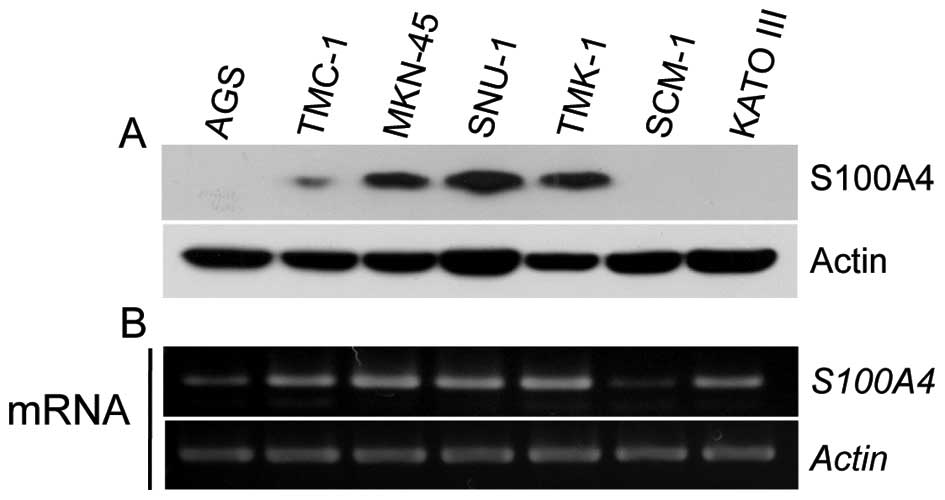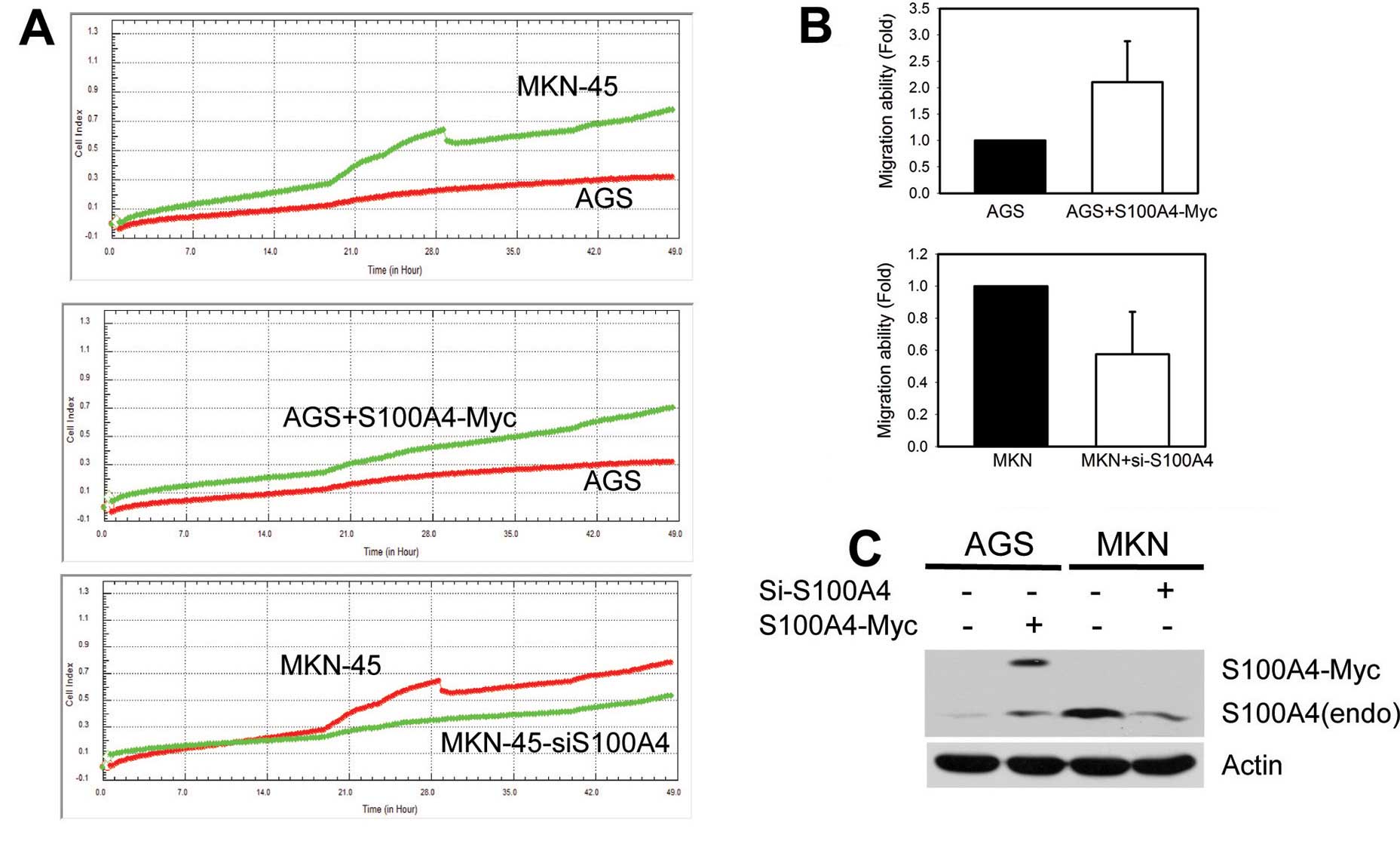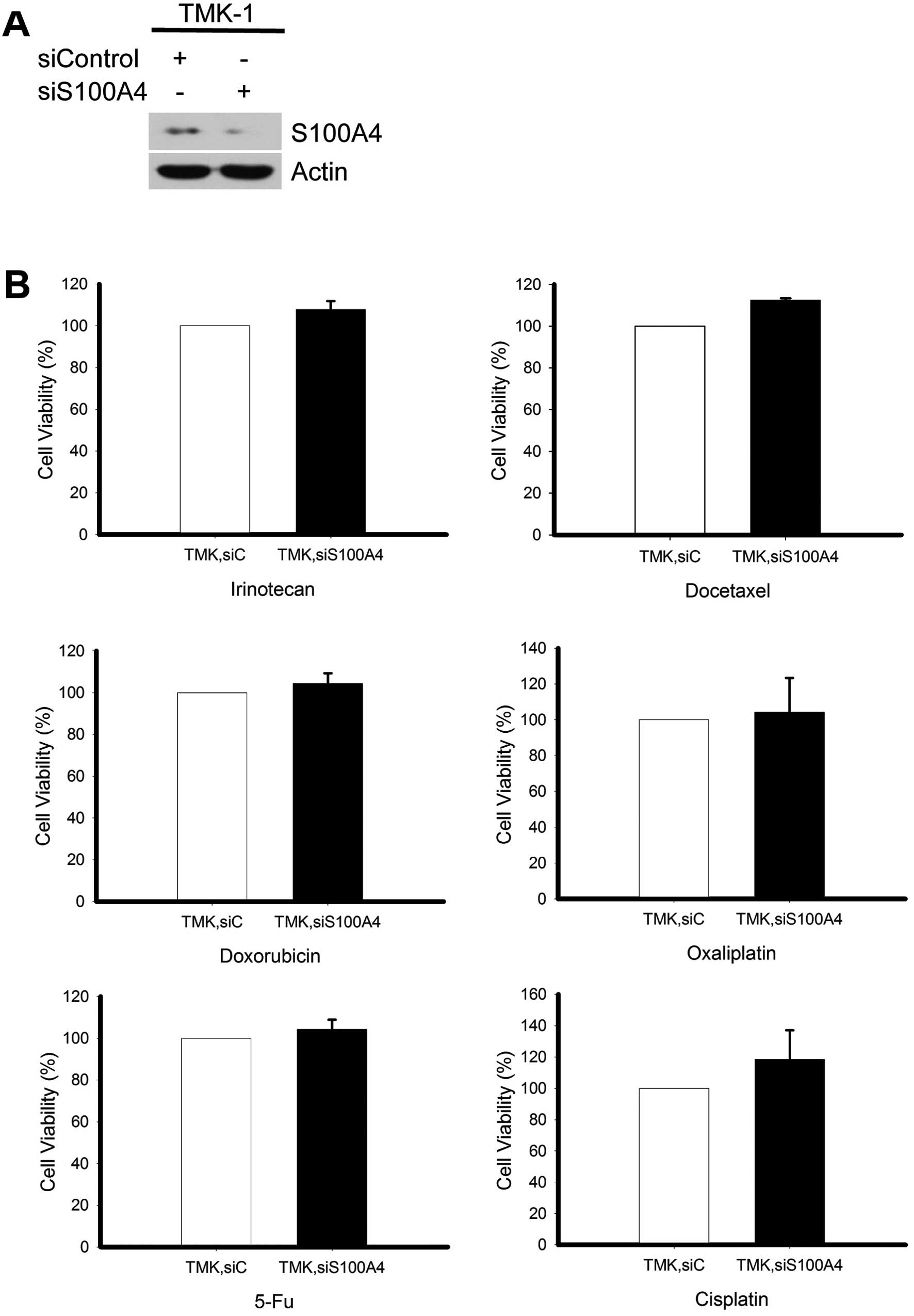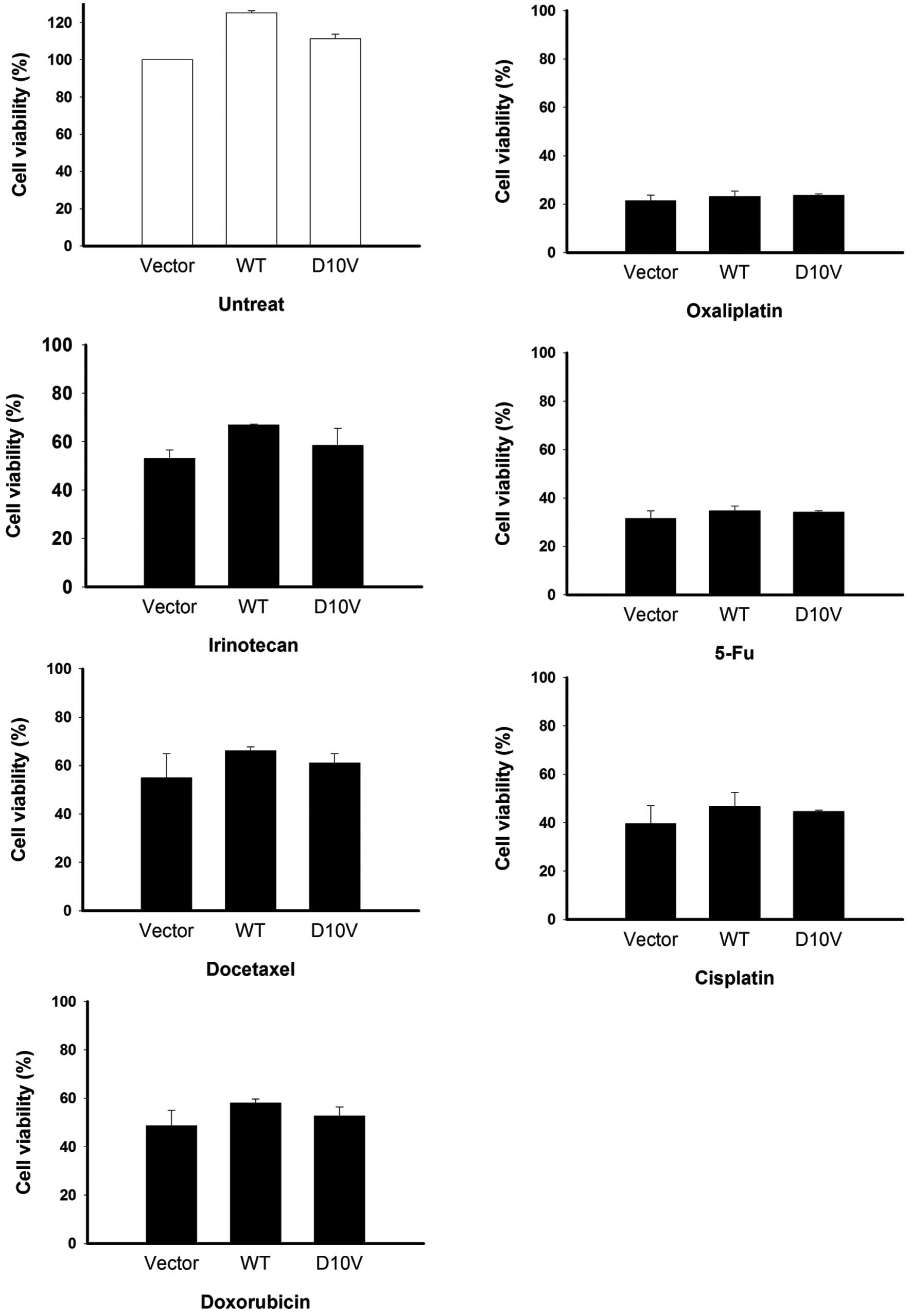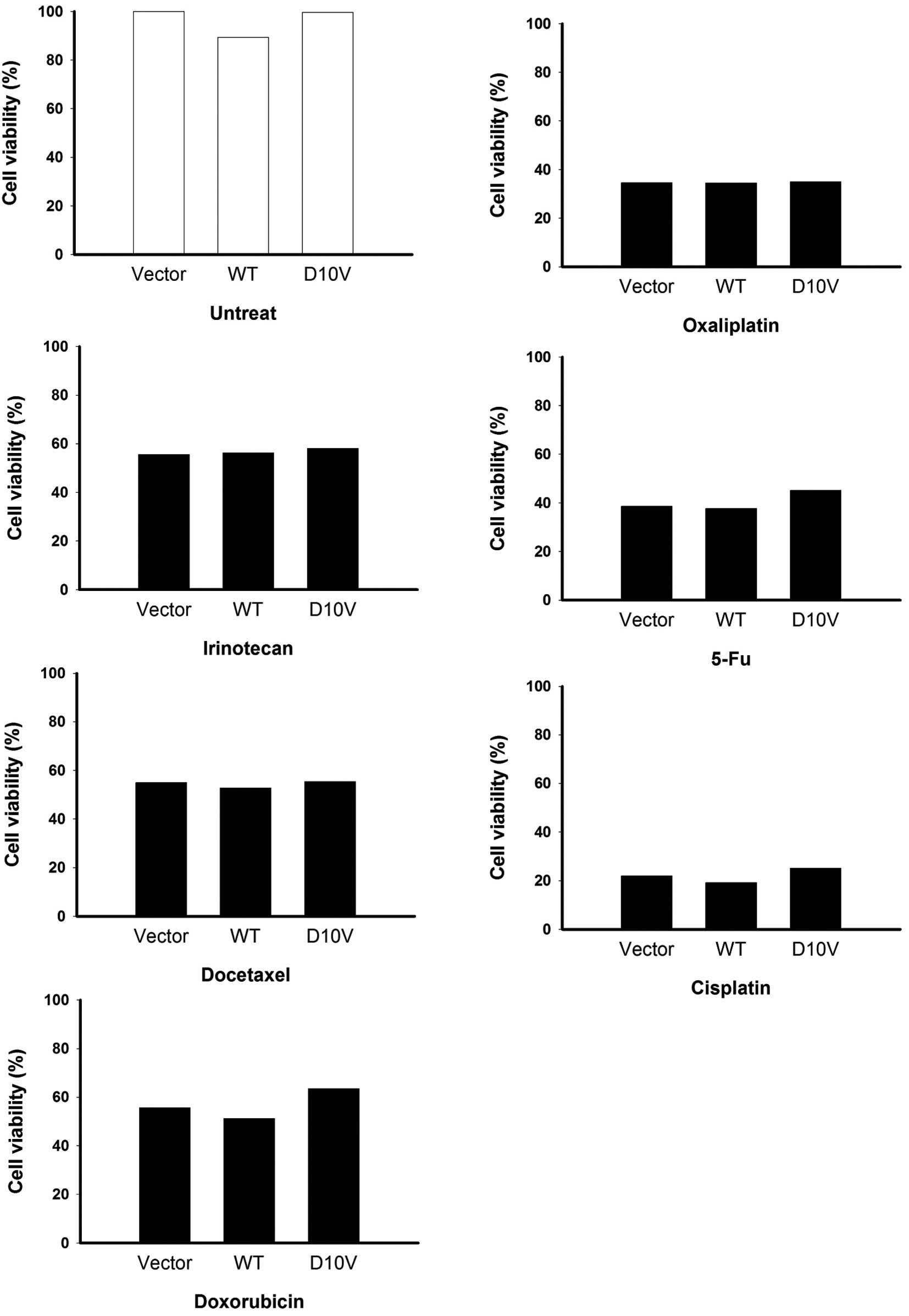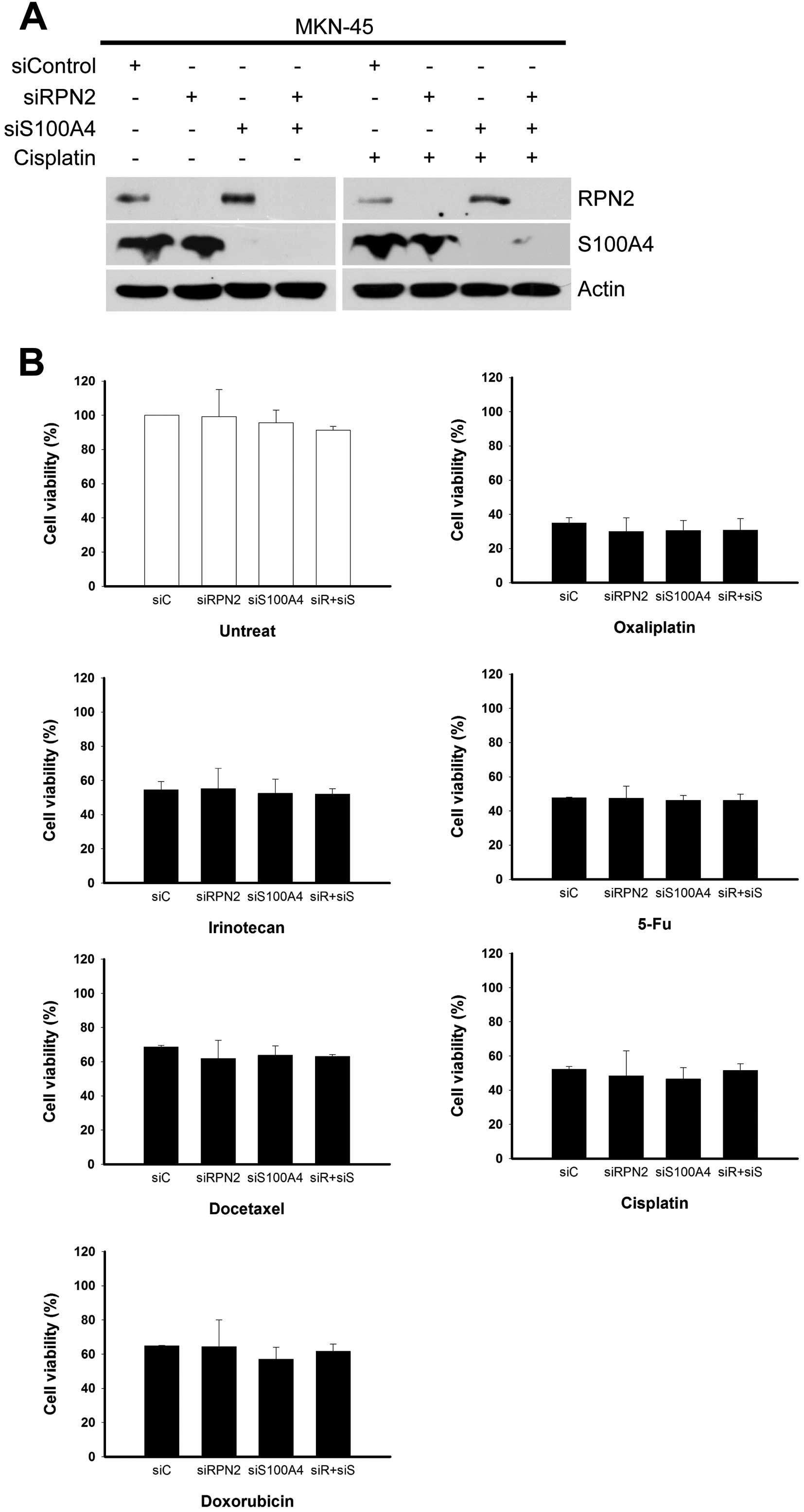The S100A4 D10V polymorphism is related to cell migration ability but not drug resistance in gastric cancer cells
- Authors:
- Published online on: October 13, 2014 https://doi.org/10.3892/or.2014.3540
- Pages: 2307-2318
-
Copyright: © Yuan et al. This is an open access article distributed under the terms of Creative Commons Attribution License [CC BY_NC 3.0].
Abstract
Introduction
The S100 proteins comprise a family of more than 25 different members (1). Found exclusively in vertebrates, these proteins are involved in activating specific biochemical pathways to regulate various cellular functions, including proliferation, survival, differentiation and motility (2). The S100 protein family has attracted increasing attention in the field of cancer research; in particular, S100A4 reportedly contributes to various aspects of tumor progression, including cell motility, metastasis and angiogenesis (3–5). S100A4 was first isolated as the product of a gene that is differentially expressed in highly metastatic mouse mammary adenocarcinoma cells (6). It has since been shown to be specifically upregulated in aggressive and advanced metastatic tumors relative to non-invasive, non-metastatic tumors (7,8). Elevated expression of S100A4 has been found in numerous cancer types; its expression in non-metastatic cell lines was shown to trigger a more metastatic phenotype (9,7), whereas decreased S100A4 expression was associated with a lower metastatic capacity (10,11). Furthermore, transgenic animal studies have established positive associations between S100A4 and both metastasis and tumor development (12–15). Clinical studies have convincingly demonstrated that significant expression of S100A4 in primary tumors is indicative of poor prognosis (16–18), and that S100A4 may be a useful marker for predicting the development, progression and metastasis of human gastric cancer (19).
Despite these findings, however, we do not yet fully understand the exact mechanisms through which S100A4 executes its pro-metastatic functions. Intracellular S100A4 has been shown to interact with non-muscle myosin IIA at the leading edge of migrating cells, which may promote cell migration (20). In addition, S100A4 may modulate the expression levels of MMP9 and MMP13, thereby regulating invasion and metastasis in human prostate and breast cancer cells (21,22), respectively. In esophageal squamous cell carcinoma, the ability of S100A4 to promote tumor invasion and metastasis is associated with the upregulation of MMP2 and the down-regulation of E-cadherin (23). Moreover, Lo et al showed that S100A4 induced epithelial-mesenchymal transition (EMT) to maintain the stemness of cancer cells and the tumorigenic properties of head and neck cancers (24).
In addition to acting intracellularly, some of the S100 proteins demonstrate extracellular activity by acting as chemo-attractants. S100A4 can be secreted, and several lines of evidence suggest that it can induce cytokine networks, such as those mediated by the inflammatory cytokines IL8, CCL2 and SAA, thereby enabling tumor cells to engage with angiogenic and inflammatory stromal cells (25,26). In this regard, S100A4 is believed to have potential as a highly prognostic molecular biomarker for metastatic potential, as already shown for breast, colorectal, gallbladder, pancreatic as well as other types of cancer (3,18).
However, although data indicate that high-level expression of S100A4 is associated with increased metastatic capacity, we are only just beginning to unravel the potential roles of this protein in chemoresistance. Moderate S100A4 overexpression was found in a doxorubicin-resistant colon cancer cell line compared to doxorubicin-sensitive cells (27), whereas S100A4 knockdown was associated with upregulation of BNIP3, increased sensitivity of pancreatic ductal adenocarcinoma cell lines to gemcitabine treatment, and enhanced apoptosis (28). Furthermore, S100A4 mRNA and protein levels were found to be upregulated in methotrexate (MTX)-resistant cancer cells and to contribute to MTX resistance (29). Other S100 family proteins have also been demonstrated to contribute to chemoresistance (30,27). Despite these previous findings, however, the involvement of S100A4 in the drug responsiveness of gastric cancer remains less well understood.
Considering the upregulation of S100A4 in metastatic tumors and the literature correlating its expression with poor prognosis, we investigated whether S100A4 may mediate chemotherapeutic resistance in gastric cancer. Here, we reported that ectopic expression of S100A4 did not promote anticancer drug resistance in gastric cancer cells, and S100A4 knockdown had little effect on the survival of drug-treated cells. These data strongly suggest that, depending on the cell context, the metastasis-promoting effect of S100A4 may not be positively correlated with anticancer drug resistance in the clinic.
Materials and methods
Cell culture
The human gastric carcinoma cell lines, AGS, TMC-1, SNU-1, TMK-1, SCM-1, MKN-45, and KATO III, were cultured in RPMI-1640 (Invitrogen, Carlsbad, CA, USA) supplemented with 10% fetal bovine serum (FBS), sodium bicarbonate (2%, w/v), L-glutamine (0.29 mg/ml), penicillin (100 U/ml), and streptomycin (100 μg/ml) (Invitrogen) at 37°C in a humidified 5% CO2 incubator.
Antibodies and chemicals
Specific antibodies against S100A4, ribophorin II (RPN2) and β-actin were obtained from Santa Cruz Biotechnology (Santa Cruz, CA, USA). Anti-PARP and anti-caspase-3 were obtained from Cell Signaling Technology (Beverly, MA, USA). Anti-Myc was purchased from Millipore (Millipore Corporation, Bedford, MA, USA). Cisplatin was purchased from Sigma (St. Louis, MO, USA).
MTS assays
Cells (5×103) were seeded in 96-well culture plates, incubated overnight at 37°C in medium containing 10% FBS, and then treated with the indicated concentrations of anticancer drugs for 48 h. Cell viability was determined using an MTS colorimetric assay (CellTiter 96® cell proliferation assay kit; Promega, Madison, WI, USA) as described by the manufacturer. All experiments were performed at least in triplicate, on three separate occasions. A dose-response curve was plotted, and the drug concentration that decreased color development by 50% (i.e., the IC50 value) was calculated for each drug. The data are presented as means ± SDs.
RNA interference
For small-interfering RNA (siRNA) knockdown of S100A4, ON-TARGET plus SMART pool siRNAs against S100A4 were purchased from Dharmacon Research (Lafayette, CO, USA). Non-targeting siRNA duplexes were used as negative controls (Dharmacon Research). Cells were transfected with siRNA using Lipofectamine RNAiMAX (Invitrogen) and incubated in glucose-free Opti-MEM (Invitrogen) according to the manufacturer’s recommendations.
Western blot analysis
Cell extracts were prepared in lysis buffer (50 mM HEPES, pH 7.5, 150 mM NaCl, 5 mM EDTA, 1% Triton X-100, 50 mM NaF, 1 mM Na3VO4, 10% glycerol, and a protease inhibitor cocktail). Equal amounts of proteins were separated by sodium dodecyl sulfate-polyacrylamide gel electrophoresis (SDS-PAGE) and transferred to polyvinylidene difluoride (PVDF) membranes (Millipore, Billerica, MA, USA). The membranes were blocked, washed, probed with the indicated primary antibodies, washed again, and incubated with horseradish peroxidase-conjugated secondary antibodies for 1 h. Finally, the blots were washed, and then developed using enhanced chemiluminescence (ECL) reagents (Millipore) according to the manufacturer’s protocol.
Reverse transcription-polymerase chain reaction (RT-PCR) analysis
RNA was isolated from cultured cells using the TRIzol reagent (Invitrogen) according to the manufacturer’s instructions, and cDNA was synthesized from 2 μg of total RNA by reverse transcription using the ImProm-II Reverse Transcriptase kit (Promega) with oligo(dT)12–18 primers. The resulting cDNA was used for subsequent PCR using specific PCR primers for S100A4 (forward, 5′-ATGGCGTGCCCTCTGGAG-3′ and reverse, 5′-TTTCTTCCTGGGCTGC-3′).
Site-directed mutagenesis
The full-length human S100A4 cDNA was inserted into pcDNA3.1 (Invitrogen) to express the S100A4-Myc recombinant protein. Asp-10 was substituted with a valine residue using a QuikChange II Site-Directed Mutagenesis kit (Stratagene, La Jolla, CA, USA) using specific DNA oligonucleotides (D10V forward, 5′-GAGAAGGCCCTGGTTGTGATGGTGTCC-3′ and D10V reverse, 5′-GGACACCATCACAACCAGGGCCTTCTC-3′).
Real-time cell analysis (RTCA) system
For continuous monitoring of cell migration, cells (1×104 cells/well) suspended in serum-free medium were seeded into the upper compartment of CIM-plates 16 (Roche, Mannheim, Germany). The lower compartment was then filled with medium containing 10% FBS and incubated in the RTCA station (xCELLigence System, Roche). Cell migration was monitored for 24 h with impedance measured every 15 min. Cell impedance was represented as cell index (CI) = (Zi-Z0) [Ohm]/15[Ohm], where Z0 was the background resistance and Zi was the resistance at a given time-point. A normalized cell index was determined as the cell index at a given time-point (CIti) divided by the cell index at the normalization time-point (CInml_time).
Cell migration assay
The in vitro cell migration assay was performed in Transwell chambers (Millipore), using 8.0-μm pore-size filters according to the manufacturer’s recommendations. Briefly, 1×105 cells were suspended in serum-free DMEM and seeded to the upper compartment of a Transwell insert, while the lower compartment was loaded with a 24-well dish containing medium supplemented with 10% FBS. After incubation at 37°C in 5% CO2 for 18 h, a cotton swab was used to remove the non-migrated cells from the upper surface of the membrane. The cells that had migrated through the membrane and adhered to the lower surface were fixed with methanol and then stained with crystal violet (1% crystal violet in 75% ethanol). The cells were examined under a microscope and counted. Experiments were performed in triplicate, and the results were calculated by averaging the total number of cells from three membranes.
Statistical analyses
All experiments were performed in triplicate. The significances of between-group differences were determined using the Student’s t-test. A P-value <0.05 was considered to indicate a statistically significant difference.
Results
S100A4 expression and cell migration
First, we examined the expression levels of S100A4 in seven gastric cancer cell lines. S100A4 was found to be highly expressed in MKN-45, SNU-1 and TMK-1 cells at both the protein and mRNA levels, whereas AGS and SCM-1 cells exhibited much lower expression of S100A4 at the protein and mRNA levels (Fig. 1). We therefore used AGS, MKN-45, TMK-1, and SCM-1 cells in our subsequent studies. To examine the functional significance of S100A4 in the cell migration of these gastric cancer cell lines, we used the RTCA system, which is a label-free, real-time automated continuous-monitoring platform that assesses cell migration by measuring changes in the electrical impedance at the electrode/cell interface. As shown in Fig. 2, higher expression levels of endogenous S100A4 were significantly associated with the higher migration ability of MKN-45 cells compared to AGS cells. Moreover, the migration ability of AGS cells was markedly enhanced by ectopic expression of S100A-Myc, whereas siRNA-mediated knockdown of endogenous S100A4 expression attenuated the cell migration of MKN-45 cells (Fig. 2A–C). Consistent with the results from previous reports, our data confirmed that S100A4 plays a critical role in the cell migration of gastric cancer cell lines.
S100A4 expression and drug responsiveness
To investigate the role of S100A4 in anticancer drug resistance, AGS cells expressing exogenous S100A4-Myc were exposed to the half-maximal inhibitory concentrations (IC50) of six conventional anticancer drugs for 48 h. Immunoblot analysis of apoptosis-related protein markers revealed that overexpression of S100A4 slightly decreased the cisplatin-induced cleavage of caspase-3 and poly(ADP-ribose) polymerase (PARP) in AGS cells (Fig. 3A). MTS-based cell viability analyses showed that overexpression of S100A4 slightly (but not significantly) increased cell viability relative to empty-vector controls in AGS cells treated with any of the tested drugs (Fig. 3B). Next, MKN-45 cells were subjected to siRNA-mediated knockdown of S100A4 (siS100A4) for 24 h and then challenged with anticancer drugs for 48 h. S100A4 knockdown slightly increased the cisplatin-induced cleavage of caspase-3 and PARP, and decreased BCL2 protein levels (Fig. 4A). However, our MTS-based analysis of cell viability indicated that knockdown of S100A4 did not have any discernible effect on cell survival (Fig. 4B). A similar pattern of drug responsiveness was obtained in TMK-1 cells, wherein significant knockdown of S100A4 (Fig. 5A) did not alter the resistance to various anticancer drugs (Fig. 5B).
The S100A4 D10V polymorphism affects the cell migration ability of gastric cancer cells
Numerous proteins have been identified as potentially interacting with S100 proteins, including Annexin II. (18,31) We selected nonsynonymous single-nucleotide polymorphisms (SNPs) in S100A4 from dbSNP, and examined whether they alter the biological function of the protein. We identified an SNP of S100A4 (NM_002961.2: c.29A>T, rs1803245) that resulted in the substitution of an Asp residue with a Val residue (NP002952.1:p.Asp10Val), and further found that it localizes within a sequence that is conserved among the members of the S100A protein family (Fig. 6A). Computer modeling of the S100A4 protein structure showed that the D10 residue is localized within the binding surface for Annexin II (Fig. 6B). To examine the potential significance of this SNP in cancer cell migration and anticancer drug resistance, we next examined whether cancer cells expressing this S100A4 protein variant showed changes in their metastasis-related properties. AGS cells were transfected with wild-type S100A4D10 (A allele) or S100A4D10V (T allele), and cell motility was assessed by an in vitro cell migration assay. Compared to cells expressing S100A4D10, those expressing S100A4D10V showed significantly fewer instances of traversing the membrane (P<0.01) (Fig. 6C and D). This suggests that S100A4D10V is negatively correlated with cancer cell motility compared to the wild-type.
The S100A4 D10V polymorphism does not affect anticancer drug responsiveness in gastric cancer cells
The drug responsiveness of cells expressing S100A4D10V was further investigated. AGS cells overexpressing S100A4D10V were individually treated with the six tested anticancer drugs for 48 h, and cell viability was determined. As shown in Fig. 7, the D10V substitution was not found to correlate with drug responsiveness. Similar results were obtained in SCM-1 cells expressing S100A4D10V (Fig. 8). Overexpression of both S100A4 versions did not have any discernible effect on cell growth in the absence of drugs (Figs. 7 and 8), with the exception of a slight enhancement of viability among AGS cells (Fig. 7). Taken together, our results suggest that S100A4 contributes to cancer cell migration but not the resistance to anticancer drugs.
Dual knockdown of S100A4 and RPN2 does not affect drug responsiveness
Ribophorin II (RPN2) is a prognostic marker and has been shown to contribute to resistance against chemotherapeutic agents in human breast tumors and animal models of breast cancer (32–36). Therefore, we tested whether RPN2 depletion could have a synergistic effect in S100A4-knockdown gastric cancer cells. MKN-45 cells were subjected to simultaneous siRNA-mediated depletion of RPN2 and S100A4 for 24 h, and individually challenged with the six tested anticancer drugs for another 48 h. MTS-based assays of cell survival revealed that there was no change in cell viability among cultures subjected to RPN2 knockdown, S100A4 knockdown, or dual knockdown of RPN2 plus S100A4, regardless of drug treatment (Fig. 9).
Discussion
Researchers have investigated S100A4 for its involvement in multiple aspects of tumor progression, such as proliferation, apoptosis, cell motility, extracellular matrix remodeling and angiogenesis. Recent studies have shown that elevated S100A4 protein levels are positively correlated with various human tumors and are associated with poor prognosis in human gastric, colorectal, pancreatic, thyroid, breast, lung, prostate and renal cell cancer (18). However, the potential involvement of S100A4 in chemoresistance is not yet fully understood. To further explore the potential role of S100A4 in the drug resistance of gastric cancers, we herein investigated the correlation of S100A4 expression levels with the survival of gastric cancer cell lines exposed to anticancer drug treatment. We found that siRNA-mediated knockdown of S100A4 in gastric cancer cell lines significantly reduced cell migration but did not alter cell viability following administration of the tested drugs. Moreover, migration assays showed that cells overexpressing the S100A4D10V variant had significantly fewer instances of traversing the membrane, suggesting that the D10V (rs1803245) polymorphism may interfere with the interaction between S100A4 and Annexin II. Taken together, our data indicate that there is no significant correlation between S100A4 status and chemoresistance in the tested gastric cancer cell lines.
Several recent studies have evaluated S100A4 as a therapeutic target in preclinical models (37), and some have found that S100A4 is negatively correlated with cell growth in tumor cells. For example, the metastatic phenotype of human osteosarcoma cells was significantly inhibited by a ribozyme directed against the S100A4 gene transcript, but no effect was observed on cell proliferation or tumorigenicity in vitro and in vivo (14). A whole-human-genome microarray analysis identified S100A4 as being differentially expressed between MTX-sensitive and -resistant cells (29), showing overexpression in five of the seven tested MTX-resistant cell lines. Knockdown of S100A4 increased the sensitivity of HT29 cells toward MTX, but knockdown of S100A4 had no effect on cell viability in HT29 MTX-resistant cells, suggesting that other proteins may coordinately fulfill the drug resistance (29). Conversely, S100A4 depletion was found to suppress cell proliferation and invasiveness in pancreatic cancer cell lines characterized by high-level expression of endogenous S100A4 (38). Moreover, forced expression of S100A4 markedly accelerated the cell migration of pancreatic cancer cell lines with relatively low-level endogenous expression of S100A4, but did not affect their cell growth or invasion ability (5).
Based on the above somewhat contradictory findings, we herein analyzed the potential involvement of S100A4 in the cell motility and proliferation of gastric cancer cell lines. We failed to obtain convincing evidence supporting the involvement of S100A4 in the survival of the tested cell lines. The complex phenomenon of tumor chemoresistance likely requires both gains and losses of various functions, enabling escape from the cytotoxicity induced by chemotherapeutic agents in tumor cells. Our present results suggest that in spite of S100A4, the acquisition of cell survival and growth ability in response to chemotherapy may result from the integration of other factors, at least among the tested gastric cancer cell lines.
Although the clinical correlation between S100A4 expression and tumor metastasis is more conclusive, future studies are warranted to define the relevant interactions between S100A4 and its binding partners. Several downstream targets and interaction partners of S100A4 are involved in S100A4-mediated tumor migration and invasion (18), and S100A4 reportedly interacts with multiple molecular proteins involved in the metastatic processes of cytoskeletal rearrangement and cell motility, including F-actin, tropomyosin and the heavy chain of nonmuscle myosin II (18). By surveying an SNP database and performing computer modeling, for the first time, we identified an SNP in S100A4 (NM_002961.2: c.29A>T, rs1803245); encoding a valine substitution at D10, it is localized within the potential binding surface to Annexin II. Cell migration assays showed that the D10V substitution reduced the migration ability of the tested cell lines, as compared to cells overexpressing wild-type S100A4. Future studies are required to examine whether the interaction between S100A4 and Annexin II has functional effects, perhaps contributing to the metastatic phenotype.
In conclusion, it is likely that multiple dysregulated pathways synergistically contribute to chemoresistance in cancer cells. Here, we report that S100A4 appears to have little effect on drug responsiveness in various gastric cancer cell lines, suggesting that we should identify other relevant factors in order to improve our therapeutic strategies against gastric cancer.
Acknowledgements
This study was supported by the Ministry of Health and Welfare, Feng Yuan Hospital Research Project 101-002, Taiwan.
References
|
Santamaria-Kisiel L, Rintala-Dempsey AC and Shaw GS: Calcium-dependent and -independent interactions of the S100 protein family. Biochem J. 396:201–214. 2006. View Article : Google Scholar : PubMed/NCBI | |
|
Fritz G, Botelho HM, Morozova-Roche LA and Gomes CM: Natural and amyloid self-assembly of S100 proteins: structural basis of functional diversity. FEBS J. 277:4578–4590. 2010. View Article : Google Scholar : PubMed/NCBI | |
|
Helfman DM, Kim EJ, Lukanidin E and Grigorian M: The metastasis associated protein S100A4: role in tumour progression and metastasis. Br J Cancer. 92:1955–1958. 2005. View Article : Google Scholar : PubMed/NCBI | |
|
Boye K and Maelandsmo GM: S100A4 and metastasis: a small actor playing many roles. Am J Pathol. 176:528–535. 2010. View Article : Google Scholar : PubMed/NCBI | |
|
Sekine H, Chen N, Sato K, Saiki Y, Yoshino Y, Umetsu Y, Jin G, Nagase H, Gu Z, Fukushige S, Sunamura M and Horii A: S100A4, frequently overexpressed in various human cancers, accelerates cell motility in pancreatic cancer cells. Biochem Biophys Res Commun. 429:214–219. 2012. View Article : Google Scholar | |
|
Ebralidze A, Tulchinsky E, Grigorian M, Afanasyeva A, Senin V, Revazova E and Lukanidin E: Isolation and characterization of a gene specifically expressed in different metastatic cells and whose deduced gene product has a high degree of homology to a Ca2+-binding protein family. Genes Dev. 3:1086–1093. 1989. View Article : Google Scholar | |
|
Grigorian M, Ambartsumian N, Lykkesfeldt AE, Bastholm L, Elling F, Georgiev G and Lukanidin E: Effect of mts1 (S100A4) expression on the progression of human breast cancer cells. Int J Cancer. 67:831–841. 1996. View Article : Google Scholar : PubMed/NCBI | |
|
Yonemura Y, Endou Y, Kimura K, Fushida S, Bandou E, Taniguchi K, Kinoshita K, Ninomiya I, Sugiyama K, Heizmann CW, Schafer BW and Sasaki T: Inverse expression of S100A4 and E-cadherin is associated with metastatic potential in gastric cancer. Clin Cancer Res. 6:4234–4242. 2000.PubMed/NCBI | |
|
Davies BR, Davies MP, Gibbs FE, Barraclough R and Rudland PS: Induction of the metastatic phenotype by transfection of a benign rat mammary epithelial cell line with the gene for p9Ka, a rat calcium-binding protein, but not with the oncogene EJ-ras-1. Oncogene. 8:999–1008. 1993.PubMed/NCBI | |
|
Takenaga K, Nakamura Y and Sakiyama S: Expression of antisense RNA to S100A4 gene encoding an S100-related calcium-binding protein suppresses metastatic potential of high-metastatic Lewis lung carcinoma cells. Oncogene. 14:331–337. 1997. View Article : Google Scholar | |
|
Takenaga K, Nakanishi H, Wada K, Suzuki M, Matsuzaki O, Matsuura A and Endo H: Increased expression of S100A4, a metastasis-associated gene, in human colorectal adenocarcinomas. Clin Cancer Res. 3:2309–2316. 1997.PubMed/NCBI | |
|
Ambartsumian NS, Grigorian MS, Larsen IF, Karlstrom O, Sidenius N, Rygaard J, Georgiev G and Lukanidin E: Metastasis of mammary carcinomas in GRS/A hybrid mice transgenic for the mts1 gene. Oncogene. 13:1621–1630. 1996.PubMed/NCBI | |
|
Davies MP, Rudland PS, Robertson L, Parry EW, Jolicoeur P and Barraclough R: Expression of the calcium-binding protein S100A4 (p9Ka) in MMTV-neu transgenic mice induces metastasis of mammary tumours. Oncogene. 13:1631–1637. 1996.PubMed/NCBI | |
|
Maelandsmo GM, Hovig E, Skrede M, Engebraaten O, Florenes VA, Myklebost O, Grigorian M, Lukanidin E, Scanlon KJ and Fodstad O: Reversal of the in vivo metastatic phenotype of human tumor cells by an anti-CAPL (mts1) ribozyme. Cancer Res. 56:5490–5498. 1996.PubMed/NCBI | |
|
Saleem M, Adhami VM, Ahmad N, Gupta S and Mukhtar H: Prognostic significance of metastasis-associated protein S100A4 (Mts1) in prostate cancer progression and chemoprevention regimens in an autochthonous mouse model. Clin Cancer Res. 11:147–153. 2005. | |
|
Lee WY, Su WC, Lin PW, Guo HR, Chang TW and Chen HH: Expression of S100A4 and Met: potential predictors for metastasis and survival in early-stage breast cancer. Oncology. 66:429–438. 2004. View Article : Google Scholar | |
|
Boye K, Nesland JM, Sandstad B, Maelandsmo GM and Flatmark K: Nuclear S100A4 is a novel prognostic marker in colorectal cancer. Eur J Cancer. 46:2919–2925. 2010. View Article : Google Scholar : PubMed/NCBI | |
|
Mishra SK, Siddique HR and Saleem M: S100A4 calcium-binding protein is key player in tumor progression and metastasis: preclinical and clinical evidence. Cancer Metastasis Rev. 31:163–172. 2012. View Article : Google Scholar : PubMed/NCBI | |
|
Wang YY, Ye ZY, Zhao ZS, Tao HQ and Chu YQ: High-level expression of S100A4 correlates with lymph node metastasis and poor prognosis in patients with gastric cancer. Ann Surg Oncol. 17:89–97. 2010. View Article : Google Scholar : PubMed/NCBI | |
|
Kim EJ and Helfman DM: Characterization of the metastasis-associated protein, S100A4. Roles of calcium binding and dimerization in cellular localization and interaction with myosin. J Biol Chem. 278:30063–30073. 2003. View Article : Google Scholar : PubMed/NCBI | |
|
Saleem M, Kweon MH, Johnson JJ, Adhami VM, Elcheva I, Khan N, Bin Hafeez B, Bhat KM, Sarfaraz S, Reagan-Shaw S, Spiegelman VS, Setaluri V and Mukhtar H: S100A4 accelerates tumorigenesis and invasion of human prostate cancer through the transcriptional regulation of matrix metalloproteinase 9. Proc Natl Acad Sci USA. 103:14825–14830. 2006. View Article : Google Scholar : PubMed/NCBI | |
|
Wang L, Wang X, Liang Y, Diao X and Chen Q: S100A4 promotes invasion and angiogenesis in breast cancer MDA-MB-231 cells by upregulating matrix metalloproteinase-13. Acta Biochim Pol. 59:593–598. 2012.PubMed/NCBI | |
|
Zhang HY, Zheng XZ, Wang XH, Xuan XY, Wang F and Li SS: S100A4 mediated cell invasion and metastasis of esophageal squamous cell carcinoma via the regulation of MMP-2 and E-cadherin activity. Mol Biol Rep. 39:199–208. 2012. View Article : Google Scholar : PubMed/NCBI | |
|
Lo JF, Yu CC, Chiou SH, Huang CY, Jan CI, Lin SC, Liu CJ, Hu WY and Yu YH: The epithelial-mesenchymal transition mediator S100A4 maintains cancer-initiating cells in head and neck cancers. Cancer Res. 71:1912–1923. 2011. View Article : Google Scholar : PubMed/NCBI | |
|
Bettum IJ, Vasiliauskaite K, Nygaard V, Clancy T, Pettersen SJ, Tenstad E, Maelandsmo GM and Prasmickaite L: Metastasis-associated protein S100A4 induces a network of inflammatory cytokines that activate stromal cells to acquire pro-tumorigenic properties. Cancer Lett. 344:28–39. 2014. View Article : Google Scholar | |
|
Hansen MT, Forst B, Cremers N, Quagliata L, Ambartsumian N, Grum-Schwensen B, Klingelhofer J, Abdul-Al A, Herrmann P, Osterland M, Stein U, Nielsen GH, Scherer PE, Lukanidin E, Sleeman JP and Grigorian M: A link between inflammation and metastasis: serum amyloid A1 and A3 induce metastasis, and are targets of metastasis-inducing S100A4. Oncogene. Jan 27–2014.(Epub ahead of print). View Article : Google Scholar | |
|
Bertram J, Palfner K, Hiddemann W and Kneba M: Elevated expression of S100P, CAPL and MAGE 3 in doxorubicin-resistant cell lines: comparison of mRNA differential display reverse transcription-polymerase chain reaction and subtractive suppressive hybridization for the analysis of differential gene expression. Anticancer Drugs. 9:311–317. 1998. | |
|
Mahon PC, Baril P, Bhakta V, Chelala C, Caulee K, Harada T and Lemoine NR: S100A4 contributes to the suppression of BNIP3 expression, chemoresistance, and inhibition of apoptosis in pancreatic cancer. Cancer Res. 67:6786–6795. 2007. View Article : Google Scholar : PubMed/NCBI | |
|
Mencia N, Selga E, Rico I, de Almagro MC, Villalobos X, Ramirez S, Adan J, Hernandez JL, Noe V and Ciudad CJ: Overexpression of S100A4 in human cancer cell lines resistant to methotrexate. BMC Cancer. 10:2502010. View Article : Google Scholar : PubMed/NCBI | |
|
Acharyya S, Oskarsson T, Vanharanta S, Malladi S, Kim J, Morris PG, Manova-Todorova K, Leversha M, Hogg N, Seshan VE, Norton L, Brogi E and Massague J: A CXCL1 paracrine network links cancer chemoresistance and metastasis. Cell. 150:165–178. 2012. View Article : Google Scholar : PubMed/NCBI | |
|
Semov A, Moreno MJ, Onichtchenko A, Abulrob A, Ball M, Ekiel I, Pietrzynski G, Stanimirovic D and Alakhov V: Metastasis-associated protein S100A4 induces angiogenesis through interaction with Annexin II and accelerated plasmin formation. J Biol Chem. 280:20833–20841. 2005. View Article : Google Scholar : PubMed/NCBI | |
|
Kaushal M, Mishra AK, Sharma J, Zomawia E, Kataki A, Kapur S and Saxena S: Genomic alterations in breast cancer patients in betel quid and non betel quid chewers. PLoS One. 7:e437892012. View Article : Google Scholar : PubMed/NCBI | |
|
Zhu J, He J, Liu Y, Simeone DM and Lubman DM: Identification of glycoprotein markers for pancreatic cancer CD24+CD44+ stem-like cells using nano-LC-MS/MS and tissue microarray. J Proteome Res. 11:2272–2281. 2012. View Article : Google Scholar : PubMed/NCBI | |
|
Honma K, Iwao-Koizumi K, Takeshita F, Yamamoto Y, Yoshida T, Nishio K, Nagahara S, Kato K and Ochiya T: RPN2 gene confers docetaxel resistance in breast cancer. Nat Med. 14:939–948. 2008. View Article : Google Scholar : PubMed/NCBI | |
|
De Souza R, Zahedi P, Badame RM, Allen C and Piquette-Miller M: Chemotherapy dosing schedule influences drug resistance development in ovarian cancer. Mol Cancer Ther. 10:1289–1299. 2011.PubMed/NCBI | |
|
Kurashige J, Watanabe M, Iwatsuki M, Kinoshita K, Saito S, Nagai Y, Ishimoto T, Baba Y, Mimori K and Baba H: RPN2 expression predicts response to docetaxel in oesophageal squamous cell carcinoma. Br J Cancer. 107:1233–1238. 2012. View Article : Google Scholar : PubMed/NCBI | |
|
Hernandez JL, Padilla L, Dakhel S, Coll T, Hervas R, Adan J, Masa M, Mitjans F, Martinez JM, Coma S, Rodriguez L, Noe V, Ciudad CJ, Blasco F and Messeguer R: Therapeutic targeting of tumor growth and angiogenesis with a novel anti-S100A4 monoclonal antibody. PLoS One. 8:e724802013. View Article : Google Scholar : PubMed/NCBI | |
|
Tabata T, Tsukamoto N, Fooladi AA, Yamanaka S, Furukawa T, Ishida M, Sato D, Gu Z, Nagase H, Egawa S, Sunamura M and Horii A: RNA interference targeting against S100A4 suppresses cell growth and motility and induces apoptosis in human pancreatic cancer cells. Biochem Biophys Res Commun. 390:475–480. 2009. View Article : Google Scholar : PubMed/NCBI |



